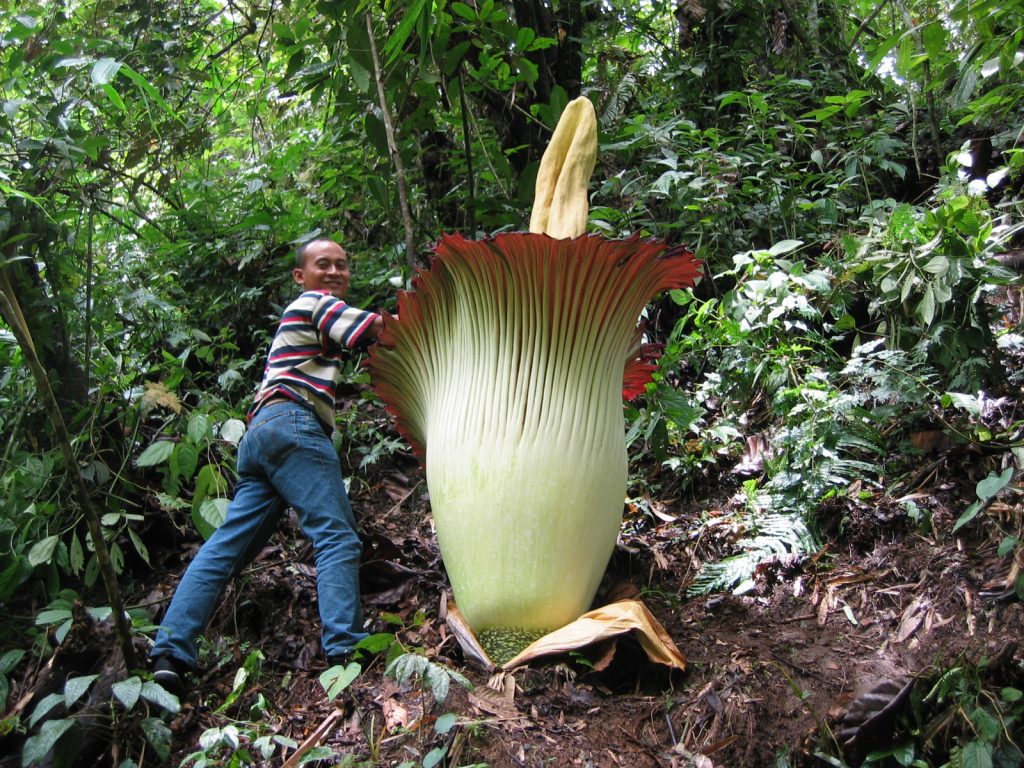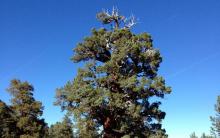TOP 35 Most Unusual and Amazing Plants in the World
The nature of our planet is extraordinary, and its imagination is inexhaustible. Outlandish representatives of the flora grow on different continents, which can amaze with their unusual appearance, size, bizarre shapes and unique properties. We present the most unusual plants that will be interesting to learn about.

This small plant, belonging to the Sundew family, attracts attention with its spectacular coloring and unusual shape of leaves collected in a rosette. However, for insects, a close acquaintance with the flycatcher becomes a fatal mistake.
In fact, this elegant plant is a ruthless predator, whose victims have no chance of salvation. The carnivorous flycatcher feeds on insects, which it catches on leaves adapted for this purpose, and then digests it, producing digestive enzymes. This small predator grows on the east coast of the United States, but can be cultivated as a houseplant.
Predatory plants. Venus flytrap

The largest water lily in the world got its name in honor of the English Queen Victoria. The plant, first discovered almost 200 years ago in the Amazon basin, is striking in the size of its leaves floating on the surface of the water. They have a round shape and peculiar “sides” of curved edges.
Victoria Amazonian leaves can reach a diameter of more than two meters and support a weight of up to 30, and in some cases up to 50 kg! From being eaten by fish and aquatic animals, the huge leaves are protected by sharp and long thorns with which their surface is studded on the underside. This side is brownish-red or dark purple in color.
The water lily blooms once a year, and flowering lasts only 2-3 days. Its large flowers, with a diameter of 20-30 cm, bloom in the evening, and in the morning they plunge into the water to reappear above the water surface in the afternoon.
Each flower has up to 60 petals:
- at the beginning of flowering they are milky white in color
- the next day their color becomes soft pink
- then it changes to purple or dark crimson
After this, the flowers disappear under water and do not appear again. Victoria Amazonica lives up to 5 years in the wild. This extraordinary water lily is one of the most popular greenhouse plants and adorns the collections of many botanical gardens around the world.

When you mention these mighty trees, you immediately imagine the hot African savannah where they grow. Baobabs are one of the thickest trees, whose diameter can reach 8 m and height up to 25 m.
These African giants do not have growth rings, so it is impossible to accurately determine their age, but scientists estimate that it could be several thousand years. On rare rainy days, the baobab tree is able to accumulate water. The thick trunk can hold up to 120 thousand liters of water! To reduce its consumption, the tree usually sheds its leaves during dry periods.

An unusual perennial plant found in the tropical regions of Southeast Asia, Africa, Australia and South America. It prefers flat areas of moist equatorial forests and grows in height from 40 to 100 cm.
A particularly interesting species of plant is called Takka Chantrier. The bizarre flower can be mistaken for a large insect or bat. Its “wings” are each 15-20 cm wide, and cord-like threads up to 70 cm long hang from the middle of the flower.
You can try to grow this plant at home. It is capricious and requires special conditions and constant attention. However, the reward for your labors will be outlandish inflorescences of dark purple, almost black color.

This tree grows in North America and is the symbol of the state of Alabama. Swamp pine is decorative and exceptionally fire resistant.
It grows up to 47 meters in height. The swamp pine was included in the list of unusual plants as the owner of the longest needles: they can reach 45 cm in length.

There are 170 known species of this plant, which is a representative of tropical and subtropical zones:
- Africa
- Australia
- Oceania
It grows from underground tubers and comes in different sizes. The largest is considered to be Amorphophallus titanica, which was discovered on the island of Sumatra. The tuber of the plant reaches 50 kg, and its inflorescence is the largest in the world and can be 2.5 m in height and 1.5 m in width.
Amorphophallus blooms once every 5 or 10 years, and flowering lasts only two days. Those wishing to admire this mesmerizing spectacle must put up with the disgusting smell of rot that the plant emits to attract pollinating insects.

Bananas, which have already become familiar to us, have every right to a place on the list of the most unusual plants, and there are many reasons for this:
- The banana palm is not a tree, but a grass. Banana is considered one of the largest herbaceous plants in the world.
- The banana fruit is not a fruit, but a berry. The infructescence can number up to 300 fruits and weigh up to 50-60 kg.
- Allergies to bananas are very rare.
- Cultivated forms of banana reproduce only vegetatively, since the fruits do not have seeds.
- In the places where it grows, banana is considered a medicinal plant.
In folk medicine, almost all parts of the banana that have healing powers are used: flowers, juice, young leaves, roots and fruits. The peel is used in cosmetology. Just 2 bananas can provide the body with enough energy for 1.5 hours of intense training.
The fruits are a natural sedative. Banana pulp contains tryptophan, an amino acid that is converted in the body into the hormone of good mood and calmness, serotonin.

Yucca brevifolia is an evergreen perennial plant also called Joshua tree. This unusual tree grows wild in the desert areas of the Southwestern United States., in four states: Utah, Nevada, Arizona and California, where Joshua Tree National Park was created. The oldest specimens can be several hundred years old.

This relict plant lives in the most ancient desert of our planet - the Namib, which is located in the southwest of the African continent. Looking at a dry pile of leaves with dead edges, you can’t immediately understand that this is a living plant, and it lives for a very long time: Some specimens are up to 2000 years old.
Velvichia has only two leaves that come out of the rosette and look like boards to the touch. Their number never increases, but they can be divided into narrow ribbons. The leaves grow throughout the life of the plant, growing annually by 30-40 cm, have a width of 1-2 m, and can reach 4-8 m in length.
Velvichia amazing grows in a harsh desert with an annual rainfall of only 10-13 mm. The plant takes moisture exclusively from the fogs that the westerly wind brings from the Atlantic Ocean.

This is the name of aloe dichotomous, which grows in the southwest of the African continent. Local tribes used its hollowed out branches as arrow quivers, hence its name. At the tips of the branches grow rosettes of pointed succulent leaves, characteristic of aloe.
The plants reach 8-9 meters in height and have an unusual appearance, thanks to which the area where they grow has become a popular tourist destination. The Quiver Forest has been declared a national monument in Namibia.

In Asia, this prickly fruit is called the “king of fruits.” Its weight reaches several kilograms, and the pulp is rich in microelements and vitamins. In addition, it has an amazing taste and delicate consistency. But not everyone can be convinced of this, because the smell of durian is simply disgusting.
This fruit smells so nauseating that it is prohibited from being carried into taxis, airplanes, hotels and other public places. In the countries of Southeast Asia, there is even a prohibitory sign in the form of a durian crossed out with a red line.

This is one of the most common insectivorous plants. The genus contains over one hundred species, most of which grow in Australia and New Zealand. The hunting leaves of this predatory plant are covered with numerous hairs, at the tips of which droplets of sticky liquid glisten, attracting the attention of insects.
The enticing drops actually turn out to be a death trap for potential victims. The sticky mucus contains the alkaloid coniine, which has a paralytic effect and makes it impossible for insects to escape.

This plant, which belongs to the Mulberry family, is often called cowwood or milkweed. It is cultivated in Southeast Asia, Central and South America. Unlike other plants, the milky juice of which is poisonous, brosimum juice can be eaten.
The consistency of this milky-white liquid is similar to heavy cream, and the taste is similar to condensed milk.
It includes:
- sugar
- resins
- vegetable wax
Even in tropical conditions, milk tree sap does not spoil within a week. Local residents use it to replace cow's milk, and from the wax, which is released on the surface of the juice when boiled, they make candles and chewing gum.

African Hydnora grows slowly, and seeing it bloom is very rare. Flowers with fleshy petals of bright orange color reach 10-15 cm. They grow directly from the roots, since the plant has neither stems nor leaves.
Hydnora attracts insects with an unpleasant odor, luring them into a trap of closed petals. Unlike insectivorous plants, it does not digest insects, but waits for them to collect pollen and releases them after a few days.

This tree has a trunk covered with thorns, poisonous seeds and toxic sap, which the Indians of South and Central America used to smear their arrowheads. Even sawdust and smoke from burning wood can cause respiratory and eye irritation.
One type of this plant is the cracking khura, which is also called the exploding khura or dynamite tree. Such names are associated with an unusual method of seed dispersal. Ripe fruits literally explode, scattering seeds at high speed over a distance of up to 45 meters.

The perennial succulent plant grows wild in the desert regions of South and South-West Africa. However, it can often be found as a pet on our windowsills. Stapelia is unpretentious and does not cause much trouble in care.
Under favorable conditions, the plant will delight you with bright flowers that look like stars, which have a diameter of 5 to 30 cm. Stapelia flowers are unusual and beautiful, but do not rush to smell them: in order to attract insects for pollination, they emit an unpleasant, fetid odor.

The perennial plant belongs to a rare life form called grass trees. Xanthorrhoea has a tree-like trunk and rosettes of leaves reaching 1 meter.
This plant lives:
- in Australia
- on the island of Tasmania
- on some neighboring islands
Xanthorrhoea grows both in humid climates and in arid savannas where fires often occur. Tree trunks are quite resistant to fire, and leaves grow quite quickly. The plant is poisonous. In the wild it lives up to 600 years.

Rafflesia lives underground, and only flowers appear on the surface, which are remarkable for their enormous size. They have a diameter of up to 1 m and a weight of up to 8-10 kg. The plant blooms for only 4 days, emitting an unpleasant smell of rotting meat. Insects flock to it and pollinate the flower, after which a fruit similar to a pumpkin appears.

If you were surprised to see a lemon on the list of the most unusual plants on our planet, then you do not know about one unique feature of this tree. The fact is that ripe lemon fruits themselves almost never fall from the branches.
If the harvest is not harvested on time, the lemons will remain hanging on the tree all fall and winter. But the most amazing thing is that in the spring the yellow fruits will turn green again! With the onset of warmth, they continue to grow, significantly increasing in volume and acquiring a thick skin.
By autumn, such repeat lemons become rough, and their peel again acquires a yellow color. You've probably noticed two different types of lemons on store shelves:
- Small, dense, juicy, with a thin crust - these are the fruits of the first year's harvest.
- Large, with thick peel and loose pulp, these are lemons left for the second year.
Rainbow eucalyptus
This is the only type of eucalyptus that grows in the Northern Hemisphere. It lives in the rainforests of several islands in Southeast Asia. A mature tree reaches a height of 75 m and has a diameter of about 2.5 m.
Rainbow eucalyptus got its name from its unusual multi-colored bark. In young plants, the bark is bright green, but as it grows it acquires a lot of other shades:
- burgundy
- blue
- purple
- brown
- orange
In adult plants, the trunk is cast simultaneously in all the colors of the rainbow, and the color of the bark tends to constantly change. Thanks to its unusual appearance, rainbow eucalyptus has become widespread as an ornamental plant in the tropics and subtropical zones.

The highland South American plant has a life form called a “cushion plant.” The evergreen inhabitant of the harsh Andes grows at an altitude of 3.2 to 4.5 thousand meters above sea level and is protected by law in four countries in South America - Peru, Chile, Argentina and Bolivia.
Yareta looks like one big green pillow, but in fact it is a colony of many tiny perennial herbaceous plants, the waxy leaves of which fit tightly together. Yareta is a hermaphrodite and grows very slowly, approximately 1.5 cm per year. Scientists have found that the age of individual specimens reaches three thousand years.











The most beautiful motorcycles in the world
Which sea is the cleanest in the world?
Top 10 Most Expensive Furs
The largest and most luxurious casinos in the world
Knightly orders of Europe XI - XIII centuries